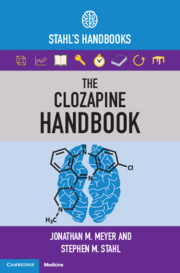Book contents
- The Clozapine Handbook
- The Clozapine Handbook
- Copyright page
- Additional material
- Contents
- Foreword
- Introduction
- 1 The Efficacy Story: Treatment-Resistant Schizophrenia, Psychogenic Polydipsia, Treatment-Intolerant Schizophrenia, Suicidality, Violence, Mania and Parkinson’s Disease Psychosis
- 2 Addressing Clozapine Positive Symptom Nonresponse in Schizophrenia Spectrum Patients
- 3 Initiating Clozapine
- 4 Discontinuing Clozapine and Management of Cholinergic Rebound
- 5 Binding Profile, Metabolism, Kinetics, Drug Interactions and Use of Plasma Levels
- 6 Understanding Hematologic Monitoring and Benign Ethnic Neutropenia
- 7 Managing Constipation
- 8 Managing Sedation, Orthostasis and Tachycardia
- 9 Managing Sialorrhea
- 10 Managing Seizure Risk and Stuttering
- 11 Managing Metabolic Adverse Effects
- 12 Fever, Myocarditis, Interstitial Nephritis, DRESS, Serositis and Cardiomyopathy
- 13 Managing Enuresis and Incontinence, Priapism, Venous Thromboembolism, Neuroleptic Malignant Syndrome, Tardive Dyskinesia and Obsessive Compulsive Disorder
- 14 Eosinophilia, Leukocytosis, Thrombocytopenia, Thrombocytosis, Anemia, Hepatic Function Abnormalities
- 15 Special Topics: Child and Adolescent Patients, Elderly Patients, Patients With Intellectual Disability, Pregnancy and Risk for Major Congenital Malformation, Lactation, Overdose, Postmortem Redistribution
- Index
- References
3 - Initiating Clozapine
Published online by Cambridge University Press: 19 October 2021
- The Clozapine Handbook
- The Clozapine Handbook
- Copyright page
- Additional material
- Contents
- Foreword
- Introduction
- 1 The Efficacy Story: Treatment-Resistant Schizophrenia, Psychogenic Polydipsia, Treatment-Intolerant Schizophrenia, Suicidality, Violence, Mania and Parkinson’s Disease Psychosis
- 2 Addressing Clozapine Positive Symptom Nonresponse in Schizophrenia Spectrum Patients
- 3 Initiating Clozapine
- 4 Discontinuing Clozapine and Management of Cholinergic Rebound
- 5 Binding Profile, Metabolism, Kinetics, Drug Interactions and Use of Plasma Levels
- 6 Understanding Hematologic Monitoring and Benign Ethnic Neutropenia
- 7 Managing Constipation
- 8 Managing Sedation, Orthostasis and Tachycardia
- 9 Managing Sialorrhea
- 10 Managing Seizure Risk and Stuttering
- 11 Managing Metabolic Adverse Effects
- 12 Fever, Myocarditis, Interstitial Nephritis, DRESS, Serositis and Cardiomyopathy
- 13 Managing Enuresis and Incontinence, Priapism, Venous Thromboembolism, Neuroleptic Malignant Syndrome, Tardive Dyskinesia and Obsessive Compulsive Disorder
- 14 Eosinophilia, Leukocytosis, Thrombocytopenia, Thrombocytosis, Anemia, Hepatic Function Abnormalities
- 15 Special Topics: Child and Adolescent Patients, Elderly Patients, Patients With Intellectual Disability, Pregnancy and Risk for Major Congenital Malformation, Lactation, Overdose, Postmortem Redistribution
- Index
- References
Summary
The decision to start clozapine therapy derives from the accepted, evidence-based uses for this medication including treatment-resistant schizophrenia spectrum disorders, schizophrenia patients with a history of suicidality, schizophrenia spectrum patients with persistent aggression, treatment-resistant mania, and psychosis associated with Parkinson’s disease (see Chapter 1). As was discussed in Chapter 1, the greatest conundrum in determining whether a schizophrenia patient is truly resistant to other treatment is high rates of nonadherence, with subtherapeutic plasma antipsychotic levels seen in 35–44% of outpatients deemed to have treatment-resistant illness. Once a patient is a candidate based on clinical criteria, patients and caregivers must be educated about the unique benefits of clozapine, its common adverse effects, and the demands of monitoring. With many outpatients this is a conversation that is often performed over an extended period as patients try and fail other options and come to trust the clinician’s suggestion that the benefits of clozapine outweigh the burdens of treatment. An important principle to guide these discussions is that significant delays in starting clozapine may reduce the likelihood of response in treatment-resistant schizophrenia. A review of response rates among 90 patients who remained on clozapine for at least 3 months found that the response rate was 82% for those who started clozapine within 2.8 years of meeting clinical criteria for treatment resistance, but fell to 31% when clozapine was started > 2.8 years after reaching this benchmark.
- Type
- Chapter
- Information
- The Clozapine HandbookStahl's Handbooks, pp. 60 - 77Publisher: Cambridge University PressPrint publication year: 2019



